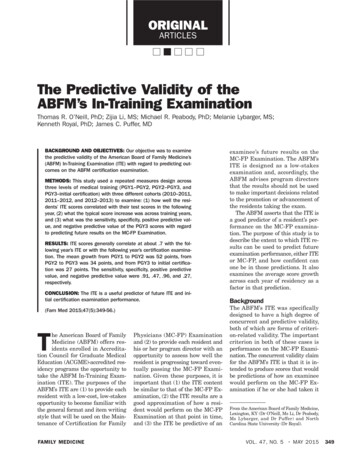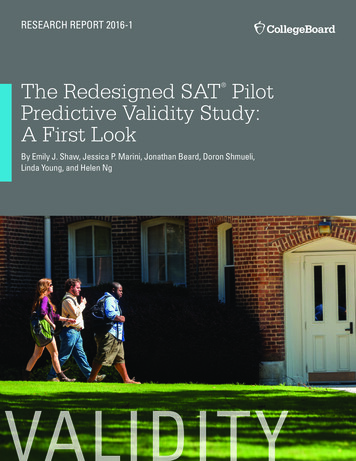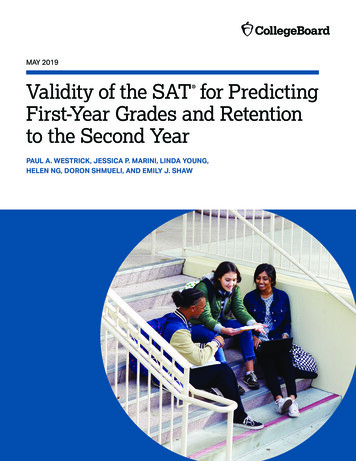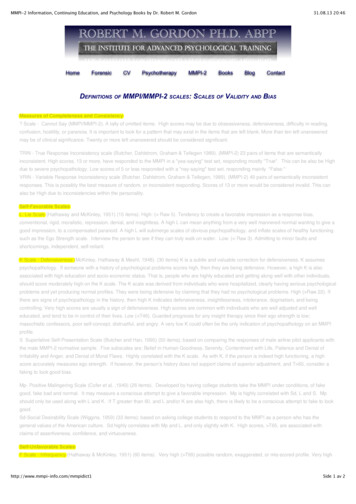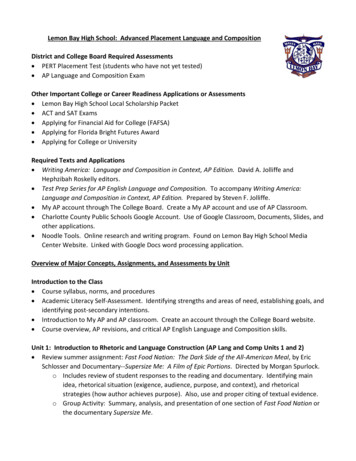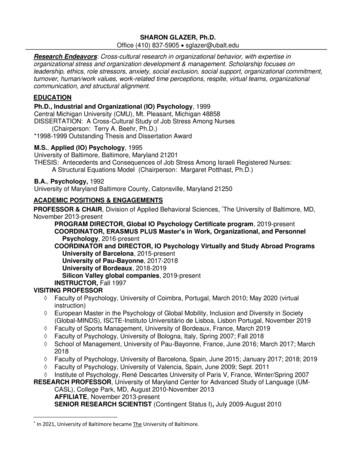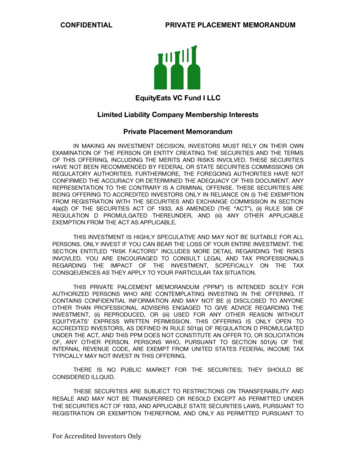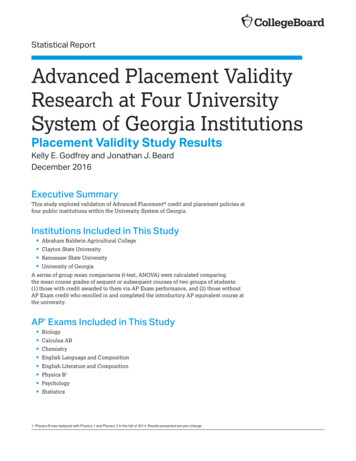
Transcription
Statistical ReportAdvanced Placement ValidityResearch at Four UniversitySystem of Georgia InstitutionsPlacement Validity Study ResultsKelly E. Godfrey and Jonathan J. BeardDecember 2016Executive SummaryThis study explored validation of Advanced Placement credit and placement policies atfour public institutions within the University System of Georgia.Institutions Included in This Study Abraham Baldwin Agricultural CollegeClayton State UniversityKennesaw State UniversityUniversity of GeorgiaA series of group mean comparisons (t-test, ANOVA) were calculated comparingthe mean course grades of sequent or subsequent courses of two groups of students:(1) those with credit awarded to them via AP Exam performance, and (2) those withoutAP Exam credit who enrolled in and completed the introductory AP equivalent course atthe university.AP Exams Included in This Study BiologyCalculus ABChemistryEnglish Language and CompositionEnglish Literature and CompositionPhysics B1PsychologyStatistics1. Physics B was replaced with Physics 1 and Physics 2 in the fall of 2014. Results presented are pre-change.
Advanced Placement Validity Research at Four University System of Georgia Institutions Statistical Report3ContentsOverview3Research Question3Institutions and Student Records4Data Considerations5Analyses and Results5AP English6AP Calculus AB7AP Biology8AP Chemistry9AP Physics B10AP Psychology11AP Statistics11AP U.S. Government and Politics12Conclusion13Appendix A: Full Comparison Results13AP English Results15AP Calculus AB17AP Biology—All Exams18AP Biology—Redesigned Exams Only19AP Chemistry20AP Physics B20AP Psychology22AP Statistics22AP U.S. Government and Politics2
Advanced Placement Validity Research at Four University System of Georgia Institutions Statistical ReportOverviewThe purpose of this study was to address AP policy-related questions fromadministrators at the University System of Georgia (USG) using current AP Exam recordsand student course performance at four institutions. Specifically, comparisons of sequentor subsequent course grades were made between AP and non-AP students. This reportdetails the AP Exam titles and institutions studied, analysis methods, and results, as wellas data considerations to note.Research QuestionThis study focused on examining the credit and placement policy or policies at the fourinstitutions across multiple subject areas. Therefore, we proposed one research questionfor each exam title:How do AP Exam credit-holding students perform in sequent or subsequent coursescompared to students without credit who took the corresponding introductory course atthe institution?Institutions and Student RecordsFour representative institutions, one from each USG institutional sector, were selected byUSG for study.These are: Abraham Baldwin Agricultural College (ABAC)Clayton State University (CSU)Kennesaw State University (KSU)University of Georgia (UGA)Students in this study were first-time entering first-year students in the fall of 2013. Twoacademic years of course data for this cohort were included: 2013-14 and 2014-15. Courserecords from the institutions were matched to College Board AP Exam records usingstudent identifying information. Due to varying AP Exam volumes, not all institutionswere included in analyses for each AP Exam title. Table 1 presents the breakdown ofwhich institution(s) were included in the analysis of each AP Exam title. The combinationof AP English Language and Composition and AP English Literature and Composition(referred to as “English”) is the only area where all four institutions were able to bestudied.Table 1: Institutions Analyzed by AP ExamABACCSUKSUUGABiologyCalculus ABChemistryEnglish Language & Composition andEnglish Literature & CompositionPhysics BPsychologyStatisticsU.S. Government & Politics3
Advanced Placement Validity Research at Four University System of Georgia Institutions Statistical ReportIn addition, AP U.S. History was explored for possible inclusion, but due to examvolumes, a more flexible credit policy, and the potential influence of other history APExams, it was determined that conclusions from any analyses would contain too great anumber of limitations.Data ConsiderationsIt is important to note that certain restrictions were used to determine groups of studentsto be analyzed and compared. AP credit-holding students had to have a qualifying AP Exam score from theCollege Board records, according to the institution’s specified policy, and no recordof taking the introductory AP-equivalent course. This includes course recordsindicating withdrawal or incompletion. Non-AP credit-holding students had no record of a qualifying AP Exam score(according to their institution’s specified policy) in College Board’s records and arecord of taking the introductory AP-equivalent course at the same institution wherethe sequent or subsequent course was taken. Students were compared on sequent or subsequent course grades, ranging from0 to 4 (or F to A). To be included, the student must have earned a valid sequentor subsequent course grade. If a student took the course pass-fail or satisfactoryunsatisfactory, he or she was excluded from analyses. In cases where a student tookthe course twice, the first valid grade received was retained for analysis. In order for comparisons to be made, each group had to include at least 15 students.4
Advanced Placement Validity Research at Four University System of Georgia Institutions Statistical ReportAnalyses and ResultsAnalyses were conducted separately for each AP Exam title, with the exception ofAP English Language and Composition and AP English Literature and Composition,which are used interchangeably for potential credit and placement at each of the fourinstitutions. Detailed output from each comparison is included in the Appendix at the endof this report.AP EnglishAt all four institutions, a student is awarded credit for ENGL 1101 for a score of 3 orhigher on either AP English Language and Composition or AP English Literature andComposition. Additionally, for a score of 5 on either exam, students are also awardedcredit for ENGL 1102. Table 2 presents the results of comparing ENGL 1102 performanceof AP credit-holding students with scores of 3 or 4 on an AP English Exam to studentswithout AP English credit who took ENGL 1101 and ENGL 1102 at the same institution.These results are summarized by institution.Table 2: Sequent Course Performance, ENGL 1102NMeanGradeStandardDeviationt ValuePr t AP credit (3, 4)163.440.734.890.0001*No AP credit5442.511.20–0.160.87196.21 0.0001*9.26 0.0001*GroupAbraham Baldwin Agricultural CollegeAP—No AP0.92Clayton State UniversityAP credit (3, 4)152.871.64No AP credit3962.941.14AP—No AP–0.07Kennesaw State UniversityAP credit (3, 4)No AP credit3443.470.831,8963.160.93AP—No AP0.31University of GeorgiaAP credit (3, 4)No AP creditAP—No AP1,4403.510.518573.280.600.23*Denotes statistical significance, p 0.05Results indicate that students with AP English Exam credit who placed out of ENGL1101 and took ENGL 1102 tended to perform as well as or better than students withoutAP English credit who took ENGL 1101 and then ENGL 1102. At three of the fourinstitutions, the AP English Exam credit-holding students significantly outperformednon-AP credit-holding students, and at the fourth institution, Clayton State University,there is no significant difference between the two groups of students.5
Advanced Placement Validity Research at Four University System of Georgia Institutions Statistical ReportAP Calculus ABCredit and placement policies for AP Calculus AB Exam scores vary somewhat acrossthe four institutions, as do course numbering systems. Because analyses require at least15 students in each group in order to make comparisons, only KSU and UGA can beanalyzed and presented. Both of these institutions award credit for precalculus (MATH1113) for a score of 3 or higher on the AP Calculus AB Exam. In addition, a score of 4or higher also receives credit for Calculus I. At UGA, Calculus I is MATH 2250. At KSU,Calculus I is MATH 1190. Comparisons were calculated for Calculus I performance,meaning that students with a score of 3 on the AP Calculus AB Exam who did not takeMATH 1113 (precalculus) were compared to students without AP Calculus AB Examcredit who took MATH 1113 and Calculus I at the same institution. The results of thesecomparisons, calculated separately at each of the two institutions, are presented in Table3. It should be noted that students with a score of 3 or higher on the AP Calculus BCExam were removed from analyses in order to focus only on the placement and creditpolicy of the Calculus AB Exam.Table 3: Sequent Course Performance: Calculus IGroupNMeanGradeStandardDeviationt ValuePr t 3.880.0003*8.15 0.0001*Kennesaw State UniversityAP credit (3)323.340.90No AP credit2612.661.27AP—No AP0.69University of GeorgiaAP credit (3)1703.220.79No AP credit2862.511.06AP—No AP0.71*Denotes statistical significance, p 0.05Results indicate that at both institutions, students with an AP Calculus AB Exam scoreof 3 who placed out of MATH 1113 (precalculus) performed significantly better thanstudents without AP Calculus AB Exam credit who took MATH 1113 at the institution. Atboth KSU and UGA, the difference was approximately 7/10 of a grade point.In addition, we compared students’ performances in Calculus II. These results arepresented in Table 4. The only institution with enough students in each group takingCalculus II was UGA. Three groups of students are compared:1. Students with an AP Calculus AB Exam score of 4 or 5 and no record of precalculusor Calculus I at any institution2. Students with an AP Calculus AB Exam score of 3 with no record of precalculus whotook Calculus I at UGA3. Students with no AP Calculus AB credit who took precalculus and Calculus I at UGAAs with the first set of analyses, students with a score of 3 or higher on an AP CalculusBC Exam were removed from this analysis.6
Advanced Placement Validity Research at Four University System of Georgia Institutions Statistical ReportTable 4: Sequent Course Performance: Calculus II (UGA)GroupNMeanGradeStandardDeviationF ValuePr F2.70.0692AP credit (4, 5)1653.110.90AP credit (3)542.890.99No AP credit482.791.01*Denotes statistical significance, p 0.05Analysis shows no significant differences between the three student groups on theirperformance in Calculus II. Because no general group effect was found, post hoc pairwisecomparisons were not necessary.AP BiologyAP Biology Exam credit and placement policies vary across institutions, but only UGAhas enough students in each group to be analyzed and presented. At UGA, students withan AP Biology Exam score of 4 or 5 are awarded credit for BIOL 1107 and BIOL 1107 Lab, and students with an AP Biology Exam score of 5 are additionally awarded credit forBIOL 1108 and BIOL 1108-Lab. Analyses here focus on comparing performance in BIOL1108 and BIOL 1108-Lab because it is the sequent course for BIOL 1107 and BIOL 1107 Lab. Therefore, in these analyses, AP Biology Exam credit-holding students have a scoreof 4 on the exam.The AP Biology curriculum and exam were redesigned and the new AP Biology Examwas first administered in the spring of 2013. Therefore, students in the studied cohortincluded examinees from before and after the launch of the redesigned course andexam, and the same credit and placement policy applied to all. Results presented inTables 5 and 6 include all students, regardless of the version of AP Biology course andexam. Analyses were then run a second time, retaining AP Biology Exam credit-holdingstudents who took only the redesigned AP Biology Exam. These results are presented inTables 7 and 8.Table 5: Sequent Course Performance: BIOL 1108 (UGA)NMeanGradeStandardDeviationt ValuePr t AP credit (4)1172.880.711.460.15No AP credit3082.760.77GroupAP—No AP0.12*Denotes statistical significance, p 0.05Table 6: Sequent Course Performance: BIOL 1108-Lab (UGA)NMeanGradeStandardDeviationt ValuePr t AP credit (4)1223.540.690.980.33No AP credit3513.470.48GroupAP—No AP0.07*Denotes statistical significance, p 0.057
Advanced Placement Validity Research at Four University System of Georgia Institutions Statistical ReportResults from all AP Biology Exam credit-holding students indicate that students with anAP Biology Exam score of 4 who do not take BIOL 1107 perform as well in BIOL 1108 atUGA as students without AP Biology Exam credit who take both BIOL 1107 and 1108 atUGA. These results are the same for BIOL 1108-Lab. Analyses focused on redesigned APBiology Exam credit-holders are presented in Tables 7 and 8.Table 7: Sequent Course Performance: BIOL 1108 (UGA), Redesigned OnlyGroupNMeanGradeStandardDeviationt ValuePr t 2.30.0221*AP credit (4)712.990.69No AP credit3082.760.77AP—No AP0.23*Denotes statistical significance, p 0.05Table 8: Sequent Course Performance: BIOL 1108-Lab (UGA), Redesigned OnlyNMeanGradeStandardDeviationt ValuePr t AP credit (4)733.550.750.880.3794No AP credit3513.470.48GroupAP—No AP0.08*Denotes statistical significance, p 0.05Results from redesigned AP Biology Exam credit-holding students indicate that studentswith a redesigned AP Biology Exam score of 4 who do not take BIOL 1107 and go on totake BIOL 1108 at UGA perform significantly better than students without AP BiologyExam credit who take both BIOL 1107 and 1108 at UGA.AP ChemistryAP Chemistry Exam credit and placement policies and course numbering systems varyacross institutions, but like AP Biology, only UGA has enough students for analysis. AtUGA, students with an AP Chemistry Exam score of 4 are awarded credit for CHEM 1211and 1211-Lab, and students with a score of 5 are awarded credit for CHEM 1211 and1211-Lab, as well as CHEM 1212 and 1212-Lab. In these analyses, AP Chemistry Examcredit-holding students have a score of 4 on the exam and comparisons are made onCHEM 1212 and CHEM 1212-Lab. Results are presented in Table 9 and Table 10.Table 9: Sequent Course Performance: CHEM 1212 (UGA)GroupNMeanGradeStandardDeviationt ValuePr t 5.8 0.0001*AP credit (4)433.480.78No AP credit6982.751.06AP—No AP0.73*Denotes statistical significance, p 0.058
Advanced Placement Validity Research at Four University System of Georgia Institutions Statistical ReportTable 10: Sequent Course Performance: CHEM 1212-Lab (UGA)NMeanGradeStandardDeviationt ValuePr t AP credit (4)463.250.87–2.350.0228*No AP credit8073.550.59GroupAP—No AP–0.31*Denotes statistical significance, p 0.05Results indicate that students with an AP Chemistry Exam score of 4 who placed outof CHEM 1211 performed in CHEM 1212 significantly better than students without APChemistry Exam credit who took CHEM 1211 at UGA. However, students with an APChemistry Exam score of 4 who placed out of CHEM 1211-Lab underperformed in CHEM1212-Lab compared to students without AP Chemistry Exam credit who took CHEM1211-Lab at UGA.It is worth noting that the AP Chemistry Exam has since been redesigned (the new examwas first administered in 2014 after students in this study had already matriculated) andthe updated AP curriculum has increased focus on lab skills and practical science.AP Physics BAP Physics B Exam credit and placement policies vary across institutions, but onlyUGA has at least 15 AP Physics B Exam credit-holding students and at least 15 non-APPhysics B Exam credit-holding students in the sequent course, PHYS 1112. UGA awardsstudents with a score of 3 or 4 on the AP Physics B Exam credit for PHYS 1111 and 1111 Lab, while students with a score of 5 receive credit for PHYS 1111 and 1111-Lab andPhysics 1112 and 1112-Lab. Because PHYS 1112-Lab does not have course grades atUGA, it will not be analyzed here. In order to focus on the AP Physics B Exam policy, anystudent with a score of 3 or higher on either of the AP Physics C Exams were removedfrom analysis. Results comparing AP credit-holders (scoring a 3 or 4 on the exam) andnon-AP credit-holders are presented in Table 11.Table 11: Sequent Course Performance: PHYS 1112 (UGA)GroupNMeanGradeStandardDeviationt ValuePr t AP credit (3, 4)333.690.474.41 0.0001*No AP credit513.010.93AP—No AP0.68*Denotes statistical significance, p 0.05Results indicate that students with an AP Physics B score of 3 or 4 and placed out ofPHYS 1111 performed in PHYS 1112 significantly better than students without APPhysics Exam credit who took PHYS 1111 at UGA.9
Advanced Placement Validity Research at Four University System of Georgia Institutions Statistical ReportAP PsychologyAll four institutions selected for study had the same AP Psychology Exam credit andplacement policy: A student with an AP Psychology Exam score of 3 or higher is awardedcredit for PSYC 1101, Elementary Psychology. However, PSYC 1101 does not have aprescribed sequent course. Instead, subsequent courses with the highest enrollmentnumbers were analyzed for comparison. Both UGA and KSU had enough students in eachgroup to make a comparison in at least one subsequent Psychology course.At UGA, two courses had enough records for comparison: PSYC 3230, Abnormal Psychology PSYC 3980, Research DesignAt KSU, one course had enough records: PSYC 3305, Life Span Developmental. Anadditional course at KSU in Psychology, PSYC 2210 (Careers in Psychology), was alsoconsidered but was ultimately dismissed due to its different content focus. Results fromthese three comparison analyses are presented in Tables 12, 13, and 14.Table 12: Subsequent Course Performance: PSYC 3230 (UGA)NMeanGradeStandardDeviationt ValuePr t AP credit (3, 4, 5)1743.370.681.30.1962No AP credit1763.270.77GroupAP—No AP0.10*Denotes statistical significance, p 0.05Table 13: Subsequent Course Performance: PSYC 3980 (UGA)NMeanGradeStandardDeviationt ValuePr t AP credit (3, 4, 5)1123.430.671.250.2128No AP credit963.300.73GroupAP—No AP0.12*Denotes statistical significance, p 0.05Table 14: Subsequent Course Performance: PSYC 3305 (KSU)NMeanGradeStandardDeviationt ValuePr t AP credit (3, 4, 5)663.550.811.530.1278No AP credit2263.350.95GroupAP—No AP0.20*Denotes statistical significance, p 0.05Results indicate that students with an AP Psychology Exam score of 3 or higher whoplace out of PSYC 1101 perform in studied subsequent psychology courses as well asstudents without AP Psychology Exam credit who take PSYC 1101 at the institution.10
Advanced Placement Validity Research at Four University System of Georgia Institutions Statistical ReportAP StatisticsCredit and placement policies for the AP Statistics Exam are very similar across allfour institutions, but each institution uses a different course numbering system. OnlyUGA had enough students in each comparison group for analyses. At UGA, studentswith an AP Statistics Exam score of 3 or higher are awarded credit for STAT 2000, orIntro Statistics. The sequent course is STAT 4210, Statistical Methods. Results of thiscomparison are presented in Table 15.Table 15: Sequent Course Performance: STAT 4210 (UGA)GroupNMeanGradeStandardDeviationt ValuePr t AP credit (3, 4, 5)213.720.491.970.0598No AP credit183.280.84AP—No AP0.44*Denotes statistical significance, p 0.05Results indicate that students who scored a 3 or higher on the AP Statistics Examand placed out of STAT 2000 performed in STAT 4210 as well as students without APStatistics Exam credit who took STAT 2000 at UGA.AP U.S. Government and PoliticsIn addition to the exam titles previously listed, UGA also has enough AP U.S.Government and Politics Exam credit-holders to make comparisons. The policy statesthat students with a score of 3 or higher are awarded credit for POLS 1101 (AmericanGovernment), placing students into POLS 2000, Introduction to Political Science. Resultsfrom this comparison are presented below in Table 16.Table 16: Sequent Course Performance: POLS 2000 (UGA)GroupNMeanGradeStandardDeviationt ValuePr t AP credit (3, 4, 5)643.470.592.630.0096*No AP credit633.180.66
Abraham Baldwin Agricultural College (ABAC) . (MATH 1113) for a score of 3 or higher on the AP Calculus AB Exam. In addition, a score of 4 or higher also receives credit for Calculus I. At UGA, Calculus I is MATH 2250. At KSU, . Lab, and students with an AP Biolog
